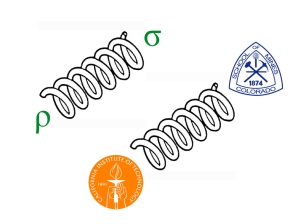“The whole not only becomes more than but very different from the sum of its parts.”
– P. W. Anderson
It was a brainstorming meeting. We went from referencing a melodramatic viral Thai video to P. W. Anderson’s famous paper, “More is Different” to a vote-splitting internally produced Caltech video to the idea of extracting an edit out of existing video we already had from prior IQIM-Parveen Shah Productions’ shoots. And just like that, stepping from one idea to the next, hopping along, I pitched a theorist vs experimentalist “interrogation”. They must have liked it because the opinion in the room hushed for a few seconds. It seemed plausibly exciting and dangerously perhaps…fresh. But what I witnessed in the room was exactly the idea of collaboration and the “storm” of the brain. This wasn’t a conclusion we could likely have arrived to if all of us were sitting alone. There was a sense of the dust settling around the chaotic storm of the collective brain(s). John Preskill, Crystal Dilworth, Spiros Michalakis and I finally agreed on a plan of action going forward. And mind you, this of course was very far from the first meeting or email we had had about the video.
Capitalizing on the instant excitement, the emails started going around. Who will be the partners in crime? A combination of personality, representation, willingness and profile were balanced to decide the participants. We reached out to Gil Refael, David Hsieh, Nai-Chang Yeh, Xie Chen and Oskar Painter. They all said “yes”! It seemed deceivingly easy. And alas it came. Once the idea of the interrogation was unleashed; pitting them against one another or should I say “with” one another, brought about a bit of anxiety and confusion at first. “Wait, we’re supposed to fight on camera?” “But, our fields don’t match necessarily.” “No, no, it just doesn’t make sense.” I was prepared for the paranoia. It was natural and a bit less than what we got back when we pitched the high-fashion shoot for geeks video. I was taking them out of their comfort zone. It was natural. I abated the fears. I told them it was not going to be that controversial.
But I had to prep it to a certain level of “conflict” or “drama” so that what we got on camera, was at least some remnant of the initial emotional intention. The questions, the “tone” had to be set. Then we realized that it wasn’t just the meeting of the professorial brains but also the other researchers of the Institute that needed to be represented. And so, we also added some post docs and graduate students. Johannes Pollanen (now already an Assistant Professor at Michigan State University), Chandni Usha and Shaun Maguire. The idea of a nebulous conversation about theory vs practical or theory and practical seemed like a literal experiment of the very idea of the formation of the IQIM: putting the best brains in the field, in a sandbox, shaking them around to see the entangled interactions produced. It seemed too perfect.
The resulting video might not have produced the exact linear narrative I desired…but it was indeed “more than the sum of its parts”. It showed the excitement, the constant interaction, the curious conversations and the anxiety of being at the forefront, the cutting edge, where one is sometimes limited by another and sometimes enabled by the other, but most importantly, constantly growing and evolving. IQIM to me signifies that community.
Being accepted and integrated as a filmmaker itself is a virtue of that forced and encouraged collaboration and interaction.
And so we began. Before we filmed, I spent time with each duo, discussing and requesting a narrative and answers to some proposed questions.
Cinematographer, Anthony C. Kuhnz, and I were excited to shoot in Keith Schwab’s spacious lab, that had produced the memorable shot of Emma Wollman for our initial promo video. It’s space and background was exactly what we needed for the blurred backgrounds of this “brain space” we were hoping to create.
The lighting was certainly inspired by an interrogation scene but dampened for the dream state. We wanted to bring people into a behind the scenes discussion of some of the most brilliant minds in quantum physics, seeing the issues and challenges that face them; the exciting possibilities that they predict. The handheld camera and the dynamic pans from one to another were also inspired to communicate that transitional and collaborative “ball toss” energy. Once you feel that tangible creativity, then we go into the depths of what IQIM really is, how it creates its community within and without, the latter by focusing on the outreach and the educational efforts to spread the magic and sparkle of Physics.
I’m proud of this video. When I watch it, whether or not I understand everything being said, I do certainly want to be engaged with IQIM and that is the hope for others who watch it.
Nature is subtle and so is the effect of this video…as in, we hope that…we gotcha!




